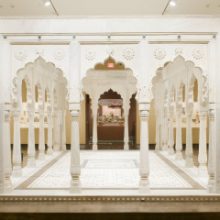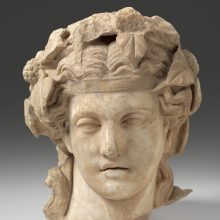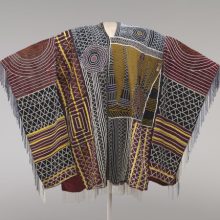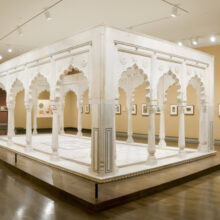Islam spread westward across northern Africa during the 7th century and then south beyond the Sahara from the 10th through the 19th century. This object, found in the museum's African Art Galleries, was made for use by a Muslim student from the Hausa culture of Nigeria in the late 19th or early 20th century. Though a century old, the student's interaction with this object is still visible in the carefully written lines of Arabic present on the surface. It is a type of writing tablet used widely throughout the Islamic areas of West Africa to teach students penmanship and to aid in memorization of Islam's holy book, the Qur'an. This refined example was probably made in the city of Kano, an Islamic center in northern Nigeria and a hub of Hausa culture. The tablet's curved base allowed the user to rest the board comfortably against the waist or legs while writing. The text on the board, written in Maghribi script, is the first part of the Qur'an's thirty-sixth sura, or chapter.
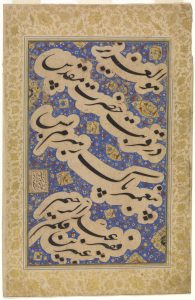
Decorative Motifs in Art of the Islamic World
The term Islamic art is frequently used as a modern way of categorizing objects created by or for Muslims. Often, but not always, these objects express aspects of the Islamic faith. Explore a few hallmarks of design in Islamic art through objects in VMFA's permanent collection.
VMFA's permanent collection of South Asian, African, and Modern Contemporary art all include works created in regions where Islam is or has been the dominant religion, or by artists from these places. Islamic art is often recognized for its ornament and decorative motifs which includes calligraphy, geometric and vegetal patterns, and symmetrical organization. With this resource, you can explore a few hallmarks of Islamic design present in works from VMFA's collection.
Learn more about art from the Islamic world by exploring this Collection story that was created in conjunction with the exhibition, Traverses: Art from the Islamic World across Time and Place.
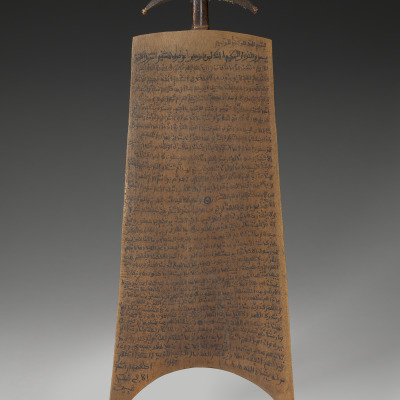
Qur’anic Writing Tablet
Islam spread westward across northern Africa during the 7th century and then south beyond the Sahara from the 10th through the 19th century. This object, found in the museum's African Art Gallerie ...
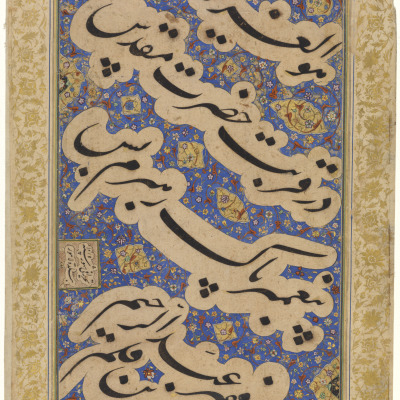
Calligraphic Album Page
Calligraphy is the most important art form in the Islamic world. Calligraphers carefully plan how to best present text in the space allotted. Words may be configured in different ways, and callig ...
Calligraphy is the most important art form in the Islamic world. Calligraphers carefully plan how to best present text in the space allotted. Words may be configured in different ways, and calligraphers have a variety of script styles to choose from.
This example, once a page of an album in which calligraphies and paintings were gathered, features elegantly penned calligraphy in Nastaʿliq script surrounded by cloudlike borders, delicately painted arabesques, and floating cartouches. Its text invokes both Allah and the Prophet Muhammad. The refined calligraphy is the work of Abdul-Rahim al-Harawi, a renowned calligrapher who left his native Persia at an early age and was employed by the Mughal emperors Akbar and Jahangir. His signature appears at the lower left, together with the honorific title bestowed on him by Jahangir: ʿAnbarin Qalam (one whose pen is like ambergris). The inscription in the small rectangle along the left border states that the calligraphy was made in Lahore in AH. 1015. This date is expressed in terms of the Islamic calendar - which begins in the year AD 622, when the Prophet Muhammad fled persecution in Mecca and went to Medina - is equivalent to AD 1606-7 of the Western calendar.
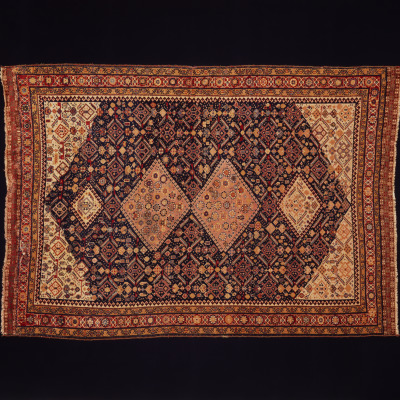
Rug
Like calligraphy, geometric patterns are used widely in Islamic art. These abstract, intricate, and complex designs can appear on a variety of objects including textiles and rugs like this one ma ...
Like calligraphy, geometric patterns are used widely in Islamic art. These abstract, intricate, and complex designs can appear on a variety of objects including textiles and rugs like this one made in Iran's Fars Province by the Quaqua'i people in the late 19th century.
The repetition of polygonal geometric forms, such as diamonds or triangles, to create an overall pattern is characteristic of Islamic design. Often, polygons are tessellated, meaning they are arranged without gaps or overlapping like the patterns along the borders of this rug. Symmetry is also at play here. Draw an imaginary line along the center of the rug, both horizontally and vertically. Now try from corner to corner. You may notice that this design is arranged so that there is symmetry along the horizontal, vertical, and diagonal axes.
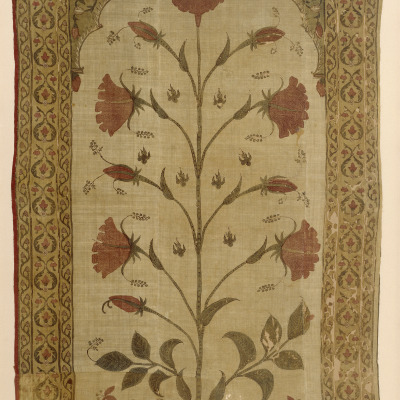
Tent Hanging (Qanat)
Textiles have a wide variety of uses. This tent hanging may once have been used by a Mughal ruler in the 18th century. The Mughal emperors were descendants of Central Asian nomads, accustomed to l ...
Textiles have a wide variety of uses. This tent hanging may once have been used by a Mughal ruler in the 18th century. The Mughal emperors were descendants of Central Asian nomads, accustomed to living in soft, portable architecture. Housed in grand tent cities, the imperial court moved between multiple capitals, visited the provinces, and followed war campaigns. Tents were made for every conceivable purpose, and many of them were lavishly decorated. This impressive block-printed and hand-dyed textile is a section of a tent wall or canvas enclosure known as a qanat and the imagery it presents is also typical of Islamic design.
Vegetation appears often in Islamic art and can be incorporated into richly complex patterns. On this tent hanging, a large flowering plant, presented at the very center of a vertically symmetrical design, appears within a cusped arch. Other stylized floral forms appear on this architectural element and the upper and lower registers, working in repetition to create intricate floral borders. A series of panels like this one would have been sewn together, and the fabric wall would have appeared as a running arcade of large, flower-filled niches.
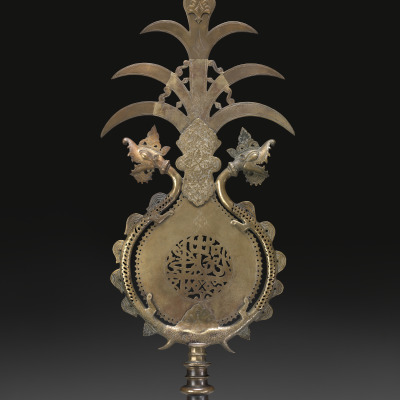
Standard ('Alam)
Between the 14th and 17th centuries, India’s central zone, called the Deccan, was ruled by a number of competing Muslim sultanates, both Sunni and Shiite. This striking brass standard or 'alam, w ...
Between the 14th and 17th centuries, India’s central zone, called the Deccan, was ruled by a number of competing Muslim sultanates, both Sunni and Shiite. This striking brass standard or 'alam, would have been mounted on top of a long pole hung with cloth and used by Deccani Shiites in processions and other religious observances during the Muslim month of Muharram. Such ‘alams are thought to be conventionalized versions of the battle standards borne by the army of Husain, grandson of the Prophet Muhammad, during his defeat at the battle of Karbala.
This object carries several Islamic decorative motifs including the calligraphic openwork Arabic script in the center medallion which invokes Allah, Muhammad, and Ali. The form of the standard is aligned with a key design principle of Islamic art. It is almost completely symmetrical so that the left side is a mirror of the right. Vegetal forms, another hallmark of Islamic design, are also present. Just above the inscription is a scalloped cruciform element embellished with intricate and intertwined floral motifs.
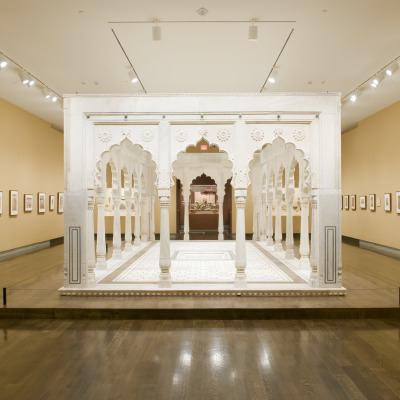
Garden Pavilion
Motifs commonly associated with Islamic art may also appear on objects made for use in other cultural contexts, including in the courts of Hindu princes in the 19th century during the time of the ...
Motifs commonly associated with Islamic art may also appear on objects made for use in other cultural contexts, including in the courts of Hindu princes in the 19th century during the time of the British Raj.
This garden pavilion, which now lacks its roof, features cusped arches enclosing a space at the center of which is a small pool. The architectural style, like the garden where it must have once stood, owes much to the influence of the Muslim Mughal dynasty. Associated with wealth and prestige, the Mughals’ refined architecture was quickly adopted by India’s many princely states and endured long after the Mughals’ decline. Stylistic comparisons suggest that this pavilion was created in the 19th century.
Tessellated geometric forms in white marble and black schist cover the pavilion's floor while stylized vegetal motifs line the scalloped edges of the buildings arches. Floral motifs reminiscent of acanthus leaves and lotus flowers decorate the structure's columns and spandrels between the archways.
Learn more about the design of the Garden Pavilion on the Beyond the Label audio tour.
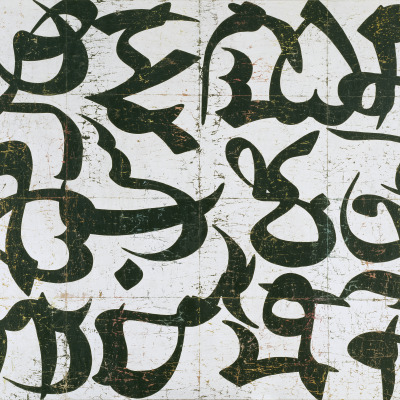
S4M53
Modern and contemporary artists sometimes draw upon the visual vocabulary, ideas, and techniques of preceding cultures in their own works of art. Iranian artist Farhad Moshiri makes works that addr ...
Modern and contemporary artists sometimes draw upon the visual vocabulary, ideas, and techniques of preceding cultures in their own works of art. Iranian artist Farhad Moshiri makes works that address the junctures between divergent cultures while refraining from direct political critique. This painting, titled S4M53, references hallmarks of Islamic design by incorporating calligraphy into the composition.
Moshiri derived the title and subject from a coded numeric writing system called Abjad, used to transcribe, in condensed form, long Islamic religious texts. In S4M53 a sample of such code is greatly enlarged and repeated in several directions, creating a deliberate cultural hybrid: a merging of monumental Islamic calligraphy with Western abstraction. Moshiri finished the painting by folding and crushing the canvas to create a network of cracks, revealing multiple sublayers, including rich areas of color. The work’s weathered surface and network of crackled lines convey a sense of time’s ravages on ancient material, an indirect commentary on the tensions between tradition and modernity in contemporary Iran.
Additional Resources
